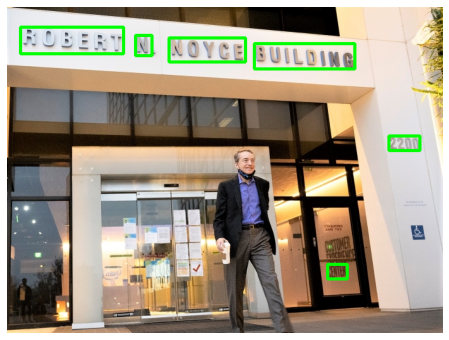Hello Object Detection¶
A very basic introduction to using object detection models with OpenVINO.
We use the
horizontal-text-detection-0001
model from the Open Model
Zoo. It detects
horizontal text in images and returns a blob of data in the shape of
[100, 5]. Each detected text box is stored in the format
[x_min, y_min, x_max, y_max, conf], where (x_min, y_min) are the
coordinates of the top left bounding box corner, (x_max, y_max) are
the coordinates of the bottom right bounding box corner and conf is
the confidence for the predicted class.
Imports¶
import cv2
import matplotlib.pyplot as plt
import numpy as np
from openvino.runtime import Core
Load the Model¶
ie = Core()
model = ie.read_model(model="model/horizontal-text-detection-0001.xml")
compiled_model = ie.compile_model(model=model, device_name="CPU")
input_layer_ir = compiled_model.input(0)
output_layer_ir = compiled_model.output("boxes")
Load an Image¶
# Text detection models expects image in BGR format
image = cv2.imread("data/intel_rnb.jpg")
# N,C,H,W = batch size, number of channels, height, width
N, C, H, W = input_layer_ir.shape
# Resize image to meet network expected input sizes
resized_image = cv2.resize(image, (W, H))
# Reshape to network input shape
input_image = np.expand_dims(resized_image.transpose(2, 0, 1), 0)
plt.imshow(cv2.cvtColor(image, cv2.COLOR_BGR2RGB));

Do Inference¶
# Create inference request
boxes = compiled_model([input_image])[output_layer_ir]
# Remove zero only boxes
boxes = boxes[~np.all(boxes == 0, axis=1)]
Visualize Results¶
# For each detection, the description has the format: [x_min, y_min, x_max, y_max, conf]
# Image passed here is in BGR format with changed width and height. To display it in colors expected by matplotlib we use cvtColor function
def convert_result_to_image(bgr_image, resized_image, boxes, threshold=0.3, conf_labels=True):
# Define colors for boxes and descriptions
colors = {"red": (255, 0, 0), "green": (0, 255, 0)}
# Fetch image shapes to calculate ratio
(real_y, real_x), (resized_y, resized_x) = bgr_image.shape[:2], resized_image.shape[:2]
ratio_x, ratio_y = real_x / resized_x, real_y / resized_y
# Convert base image from bgr to rgb format
rgb_image = cv2.cvtColor(bgr_image, cv2.COLOR_BGR2RGB)
# Iterate through non-zero boxes
for box in boxes:
# Pick confidence factor from last place in array
conf = box[-1]
if conf > threshold:
# Convert float to int and multiply corner position of each box by x and y ratio
# In case that bounding box is found at the top of the image,
# we position upper box bar little lower to make it visible on image
(x_min, y_min, x_max, y_max) = [
int(max(corner_position * ratio_y, 10)) if idx % 2
else int(corner_position * ratio_x)
for idx, corner_position in enumerate(box[:-1])
]
# Draw box based on position, parameters in rectangle function are: image, start_point, end_point, color, thickness
rgb_image = cv2.rectangle(rgb_image, (x_min, y_min), (x_max, y_max), colors["green"], 3)
# Add text to image based on position and confidence
# Parameters in text function are: image, text, bottom-left_corner_textfield, font, font_scale, color, thickness, line_type
if conf_labels:
rgb_image = cv2.putText(
rgb_image,
f"{conf:.2f}",
(x_min, y_min - 10),
cv2.FONT_HERSHEY_SIMPLEX,
0.8,
colors["red"],
1,
cv2.LINE_AA,
)
return rgb_image
plt.figure(figsize=(10, 6))
plt.axis("off")
plt.imshow(convert_result_to_image(image, resized_image, boxes, conf_labels=False));
